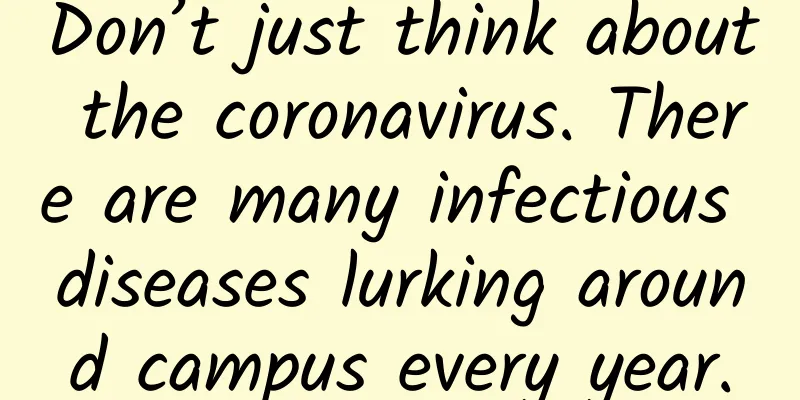Don’t just think about the coronavirus. There are many infectious diseases lurking around campus every year.

|
Spring is here, and everything is coming back to life. Elm seeds and Chinese toon buds are all edible, so we can eat them all. We can also catch tadpoles and cut willow whistles. We can also have fun with the inedible ones. Of course, there are troubles in spring, such as pollen and poplar fluff, the sandstorms that evoke memories this year, and spring infectious diseases: mumps, chickenpox, conjunctivitis, and rashes. Temperature changes, school openings, and gatherings make spring a high-incidence season for infectious diseases on campus. This issue will provide parents, prospective parents, and kindergarten, primary and secondary school teachers with a relatively detailed list of spring infectious diseases and campus epidemic prevention tips. Some people ask, I am an adult now, will these diseases not bully me? Of course not. It's just that people who have not been vaccinated and have been bullied may not live to be as old as you o(╯□╰)o Adults have a lower incidence of infection with these viruses, but they may also be bullied in a very ugly way. Written by Li Qingchao (Shandong Normal University) The plague gods in Chinese folklore are Zhang Yuanbo (picture 1), Liu Yuanda (picture 1), Zhao Gongming (picture 2), Zhong Rengui (picture 3), and Shi Wenye (picture 4). Every year, people worship the five plague gods to pray for the safety of their livestock, which reflects the Chinese working people's good wishes of exorcising evil, avoiding disasters, and praying for blessings. Putting aside superstitions and legends, seasonal periodicity is a common feature of acute infectious diseases in humans, and the plagues in the four seasons are indeed different. Figure 1: Zhang Yuanbo, the god of spring plague. Ancient books record that Zhang Yuanbo was actually a scholar who valued friendship. His "chicken and millet friendship" (killing chickens and cooking millet, and entertaining Fan Juqing) was passed down as a good story, and there is a Jishu Town in Jining City, Shandong Province to commemorate it. Affected by spring climate conditions and seasonal changes in human behavior (human cubs periodically gather in large numbers: school starts), the main infectious diseases that are prevalent in spring are rubella, measles, mumps, and chickenpox (Figure 2). Since the peak season for influenza is autumn and winter, spring is also a key season for preventing influenza. These diseases are frequent visitors to campus infectious diseases. In addition, hand, foot and mouth disease also mainly infects children, with a peak season in spring and summer in the south and a peak season in summer and autumn in the north, with a trend of gradually coming earlier. Spring epidemic prevention cannot rely on worship. Zhang Yuanbo may still be eating chicken with Fan Juqing. To get rid of diseases, you need to be strong yourself. Let's make up for it together. Influenza and chickenpox have been introduced in the previous "Virus Super Topic" column. This issue will focus on rubella, measles, mumps and hand, foot and mouth disease. Figure 2: Some infectious diseases that are prevalent in spring (Figure adapted from Jon Cohen's Science article, circles represent percentages, not absolute numbers) rubella Rubella comes and goes quickly, usually lasting three days, so it is also called three-day rash, just like a gust of wind, so it is called rubella. It is indeed "brought by the wind" - it is mainly transmitted through the air and can be easily spread from one person to another through the coughing and sneezing of infected people. Rubella is an infectious disease caused by the rubella virus (RuV) (Figure 3). Rubella virus is a single-stranded positive-sense RNA virus without an envelope, and the virus particles are icosahedral. Symptoms begin to appear about two weeks after a person is exposed to the rubella virus. The rash first starts on the face and then gradually spreads to other parts of the body. In addition to the rash, rubella can also cause swollen lymph nodes, fever, sore throat, and fatigue. Rubella infections in children and adults are usually mild and self-limited (they get better within a few days), and some people may not have symptoms after infection. However, minor illnesses can also cause big problems - if a pregnant woman who has just gotten pregnant is infected with rubella, the harm is great. If the rubella virus is infected within 20 weeks of pregnancy, it may cause miscarriage or congenital rubella syndrome (CRS) in the newborn, with symptoms such as cataracts, deafness, and can affect the heart and brain (Figure 4). Figure 3: Rubella virus and the rash, maculopapular rash, and neonatal cataracts it causes | Source: Wikipedia TORCH syndrome Infection in utero or during labor is an important cause of fetal and neonatal death and an important factor in early or late childhood morbidity. Newborns who are unfortunately infected may show abnormal growth, development or a variety of abnormal clinical and laboratory test results, which are collectively referred to as TORCH syndrome. A group of pathogens infected during the perinatal period (the important period before and after delivery, from 28 weeks of pregnancy to one week after delivery) can be vertically transmitted and cause TORCH syndrome in the fetus/neonatal: (T)oxoplasmosis – Toxoplasma gondii (O)ther Agents – Other pathogens (mainly syphilis and Zika virus) (R)ubella – Rubella (C) cytomegalovirus – Cytomegalovirus (H)erpes Simplex- Herpes simplex virus All TORCH syndromes may cause symptoms such as hepatosplenomegaly, fever, lethargy, difficulty eating, anemia, ecchymosis, purpura, jaundice and chorioretinitis in newborns, and severe cases may cause stillbirth. Figure 4: Rubella is very harmful to early pregnancy measles Measles is a highly contagious disease caused by the measles virus (Measles morbillivirus, MeV) (Figure 5), which is an enveloped virus with a single-stranded negative-strand RNA. The measles virus is also transmitted through the air and on surfaces contaminated by oral and nasal secretions. Symptoms appear 10-12 days after contact with an infected person and generally last 7-10 days. Measles symptoms are generally more severe than rubella. Initial symptoms usually include high fever, cough, runny nose and inflammation of the eyes. Two to three days after infection, white mucous patches may appear in the mouth, and three to five days later, a red, flat rash begins on the face and then spreads to other parts of the body. Other common complications caused by measles include diarrhea (8% of cases), middle ear infections (7%) and pneumonia (6%). More serious but rare complications include epilepsy, blindness and encephalitis. Figure 5: (Upper left) measles virus, (Upper right) oral mucosal plaques, (lower) maculopapular rash on the abdomen. 丨Source: Wikipedia Measles virus is one of the most transmissible viruses known (Figure 6). One measles patient can spread the virus to about 15 unimmunized people (R0 ≈12~18), far exceeding influenza (R0 ≈2~3). Measles can be prevented by two doses of safe and effective vaccines. Thanks to effective vaccines and widespread vaccination, measles is no longer common in our country. Between 2000 and 2017, measles immunization prevented an estimated 21.1 million deaths, but in 2017, 110,000 people died of measles worldwide, most of whom were children under 5 years old (WHO data). However, the global coverage of the first dose of measles vaccine has stagnated at 85% for several years. This is far from the 95% required to prevent an epidemic, leaving many individuals and communities at risk of infection; the coverage of the second dose is even lower, at only 67%. The 2020 novel coronavirus epidemic has caused routine epidemic prevention and vaccination in some areas to be unguaranteed, resulting in an increased risk of measles epidemics in some areas. Figure 6: Measles is highly contagious, but current vaccines are very effective in providing protection. Viral mumps Mumps is a viral disease caused by the mumps virus (Figure 7). Mumps virus (MuV) is an enveloped virus with a single-stranded negative-sense RNA genome. The virus particles have diverse morphologies and are mainly transmitted through respiratory secretions (such as droplets and saliva) and direct contact with infected people. Mumps is highly contagious and is particularly easy to spread in densely populated environments. Figure 7: Mumps virus | Source: Wikipedia The initial symptoms of infection with the mumps virus include fever, headache, general fatigue, muscle pain and loss of appetite. In addition, the most common symptom of infection is painful swelling of the parotid glands (remember when you were a child, all the students in your class had big cheeks?). Mumps usually occurs 16 to 18 days after exposure to the virus and disappears within two weeks. A small number of infected people may develop more serious complications, including deafness or inflammation of the testicles, breasts, ovaries, pancreas, meninges and brain. Testicular inflammation may affect fertility and even cause infertility (Figure 8). About one-third of infected people have no symptoms (lucky). Figure 8: Don’t laugh! Mumps is very painful and may also affect fertility. Source: immune.org.nz Hand, foot and mouth disease Hand, foot, and mouth disease (HFMD) usually occurs in children under five years of age, but may occasionally occur in adults. It is a common infectious disease in toddlers and school-age children (Figure 9). Unlike the previous viruses, HFMD is caused by a group of enteroviruses, the most common cause of which is infection with Coxsackievirus A16 or Enterovirus 71, which are single-stranded positive-strand non-enveloped RNA viruses. Hand, foot and mouth disease is highly contagious and can be spread through nasopharyngeal secretions (such as saliva or nasal mucus), through direct contact or the fecal-oral route. The main symptoms of hand, foot and mouth disease are fever and malaise. Another typical symptom of hand, foot and mouth disease is a rash on the palms, soles, lips, and sometimes even on the buttocks and inside the mouth. The rash caused by hand, foot and mouth disease in children is rarely itchy, but it is extremely itchy in adults. Hand, foot and mouth disease may also cause symptoms including encephalitis, meningitis and poliomyelitis. Figure 9: Papules caused by EV71 virus and hand, foot and mouth disease | Source: CDC and Wikipedia If you find your child has hand, foot and mouth disease, you should stay at home until he or she recovers. If the condition is serious, you should seek medical attention immediately. During the illness, you can drink cold drinks or eat ice cream to relieve oral pain, eat soft foods, avoid spicy, salty, and sour foods, and use warm salt water to rinse your mouth or wash your hands and feet. Hand, foot and mouth disease generally does not leave scars (Figure 10). Figure 10: Hand, foot and mouth disease is not foot-and-mouth disease Epidemic prevention and control on campus Q: How to prevent and control infectious diseases on campus? A: No school, yeah~ Q: How to avoid the many troubles in the process of parenting? Answer: Uh, mom, I’m going to study! Vaccine, vaccine, vaccine! Vaccine is the simplest and most effective measure to prevent viral diseases. my country's "National Immunization Program Vaccine Child Immunization Program and Instructions" stipulates the use of measles, mumps and rubella combined attenuated live vaccine (MMR vaccine, MMR) (Figure 11) to prevent measles, mumps and rubella, with one dose each at 8 months and 18 months of age. The MMR vaccine can protect 97% of people from measles infection, 88% from mumps and at least 97% from rubella infection. The MMR vaccine is a fairly mature vaccine that is very effective in protecting vaccinated individuals and can protect a small number of unvaccinated individuals through herd immunity. my country currently has a hand, foot and mouth disease vaccine against EV71 (Figure 11), which has a protection rate of over 90% against hand, foot and mouth disease caused by EV71. Vaccines for Coxsackievirus A6 are also under development. People who have had hand, foot and mouth disease can still choose to get the EV71 vaccine, but the EV71 vaccine cannot prevent all hand, foot and mouth diseases. You can choose to get vaccinated based on the epidemic situation of the year released by the CDC. Figure 11: MMR vaccine (left) and hand, foot and mouth disease EV71 vaccine (right) Active vaccination is very important. Take measles prevention in the United States as an example. In the 1960s, measles affected about 3,000 people per million people. With the continued popularization of childhood vaccines, by the 1980s, this number dropped to only 13 cases per million people. In 2016, measles was declared eradicated from the Americas, but there have been sporadic outbreaks since then. Due to the mischief of some people or groups, vaccine hesitancy (a negative or refusal attitude towards vaccination) has given this disease, which should have been well prevented, a chance to revive (Figure 12). For details, see "An Emmy Award-winning documentary, re-dedicating children to the god of death丨Unrolling". Figure 12: Vaccination has greatly reduced the incidence of measles, but anti-vaccine campaigns have led to local outbreaks. Source: Wikipedia What parents need to do: Undoubtedly, parents should set a good example and help their children develop good hygiene habits (if you still don’t know the correct way to wash your hands and sneeze, please click here); they also need to pay attention to their children’s health and be familiar with some common symptoms; they should understand their children’s allergens and medication contraindications, and communicate their children’s health problems and medication status with the school in a timely manner. But the most important thing to emphasize is that parents must communicate patiently, build a trusting relationship with their children and give them a sense of security, and cultivate and encourage their children to actively communicate with their parents or teachers when they encounter problems. When children make mistakes or take risks, educate them patiently and guide them correctly, and don't rush to criticize them, so as to prevent them from being afraid to communicate with their parents when encountering other things, which will delay important things. (In fact, this is the case for any problem) Why are infectious diseases seasonal? Seasonal periodicity is a common feature of acute infectious diseases in humans. Each acute infectious disease has its own specific peak season, but the peak months of the same disease in different geographical locations may be different. The seasonal periodicity of infectious diseases is mainly caused by the following factors: Environmental factors: Environmental factors, especially climate factors, are the main driving force for the outbreak of infectious diseases caused by seasonal factors. They can have a profound impact on the prevalence of infectious diseases by affecting humans or other hosts of pathogens (such as mosquitoes). Environmental factors mainly include temperature, humidity, their variation, precipitation probability, water quality, etc. For example, enveloped viruses are more stable under conditions of low temperature and small humidity changes. The classic example is influenza. Host behavior: The host is an individual such as a person or animal that can be infected by the pathogen. The seasonal contact probability between the host and the source of infection increases, which can cause seasonal outbreaks of infectious diseases. The most famous example of increased seasonal contact rates in humans is the spring semester, which causes children to gather in schools, triggering outbreaks of infectious diseases on campus, such as increased spread of measles. The increase in mosquitoes in the summer can also lead to outbreaks of insect-borne viral diseases such as dengue fever and yellow fever. Phenology and exogenous biological factors: This factor mainly refers to the host's life history, annual cycle (such as migration and hibernation) and the host's endogenous periodic rhythm (i.e. endogenously driven physiological seasonal changes). For humans, their immunity varies in different seasons, and their susceptibility to diseases is also different. Other biological factors can also affect the pattern of disease outbreaks by affecting the host. For example, the global migration of migratory birds every year creates a wave of avian influenza outbreak risks. Conclusion Children are the future of the country, the apple of their parents' eyes, and the virus's eye. Gathering on campus creates a hotbed for the spread of viruses. It is very important to prevent seasonal campus infectious diseases. Understanding infectious diseases and learning about infectious disease prevention and control knowledge is the first step to avoid panic and negligence and correctly prevent infectious diseases. Campus health requires the joint efforts of students, parents and teachers to maintain. Finally, let us take a look at the epidemic prevention recommendations given by authoritative organizations to parents and teachers through posters. Image source: https://www.unicef.cn/covid-19/safe-school-return References https://www.sciencemag.org/news/2020/03/why-do-dozens-diseases-wax-and-wane-seasons-and-will-covid-19 https://www.cdc.gov/measles/cases-outbreaks.html https://www.wikiwand.com/en/MMR_vaccine http://www.xinhuanet.com/2020-05/29/c_1126047421.htm https://www.ncbi.nlm.nih.gov/pmc/articles/PMC6224126/ https://www.unicef.cn/covid-19/safe-school-return |
<<: What is the periodic table formula? What are the first 20 elements in the periodic table?
Recommend
How to get rid of hereditary freckles
Many female friends do not pay much attention to ...
How to prevent influenza in winter and how to get better quickly
Influenza is also known as the common cold. It is...
Which department should I go to for follow-up examination after miscarriage
Women always need to follow up after a miscarriag...
What to eat to improve the hair on the body
Generally speaking, body hair is a manifestation ...
What are the types of solid breast masses?
The breasts of normal women are soft and feel fre...
Things to note after breast fibroid surgery
As long as people have undergone breast fibroid s...
What are the precautions for sleeping positions during normal childbirth? How should I sleep after giving birth?
After choosing a natural birth and giving birth s...
Nipple tilted to one side
Under normal circumstances, a woman's breasts...
When is the normal menopause age for women?
For women, the number of eggs in their lifetime i...
Are polar bears carnivores? How do polar bears breastfeed?
Polar bears are recognized by the world as the mo...
How long after a cesarean section can I hula hoop?
After a caesarean section, one month later, that ...
The reason why women have long-term stool
Modern people sit for long periods of time and do...
How do women go through menopause?
Menopause is a special period for women, during w...
What problems should I pay attention to if my menstrual flow is small?
Women are very afraid of catching cold, and low t...









